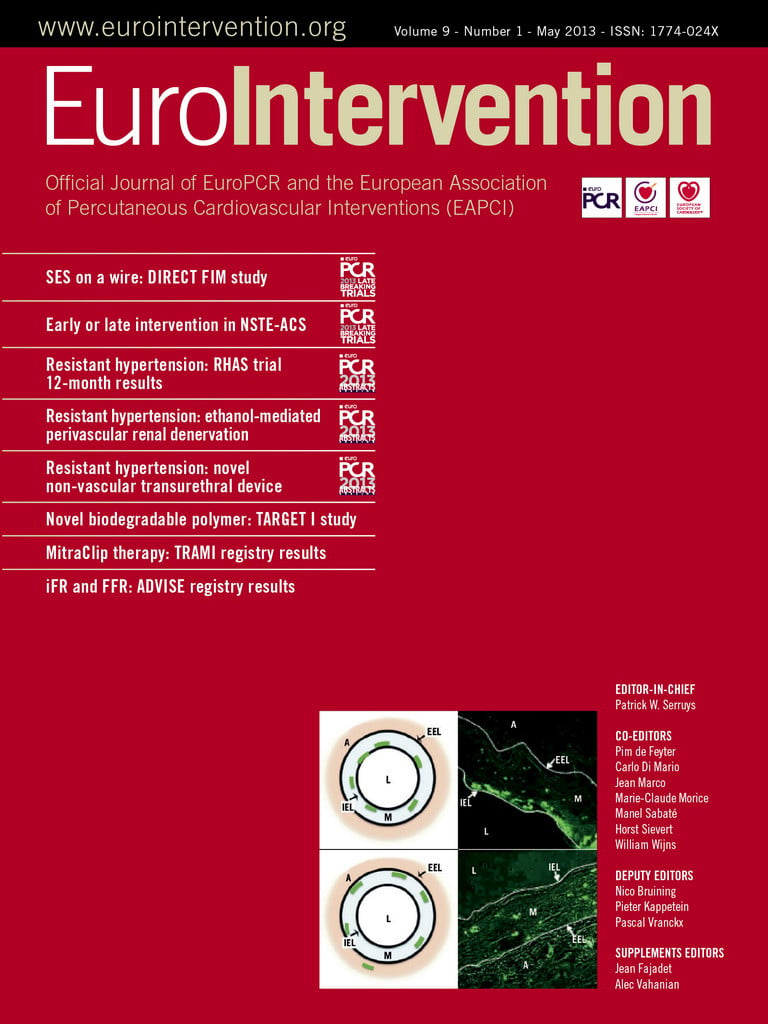Dear Editor,
We read with great interest the recent online published article by Petraco et al1 regarding the diagnostic performance of the instantaneous wave-free ratio (iFR) in a clinical registry population. We congratulate the authors on their elegant and meticulously written report. This study importantly adds to the accumulating evidence that the functional severity of a stenosis can be assessed accurately without the use of a potent vasodilator2.
The use of perfusion imaging as a gold standard for the identification of inducible myocardial ischaemia was recently criticised, and depicted as a significant impediment in adopting the premise that basal parameters can equal fractional flow reserve (FFR) in terms of diagnostic accuracy3; thus, the dogma persists that FFR is an adequate reference for comparison of novel physiological indices. An important observation by the authors is that an index cannot perform better against FFR than FFR would perform against itself. By accounting for the intrinsic FFR variability, the authors found an elegant method to account for an important limitation of using FFR as a reference standard.
We noted that the FFR distribution in the ADVISE registry differs significantly from DEFER. As the difference between mean and diastolic flow levels, and thus microvascular resistance, changes with the extent of epicardial narrowing4, we wonder to what extent the validation of iFR may be extrapolated to such a population of true intermediate stenoses in terms of wave-free resistance and its extent in comparison with mean hyperaemic resistance?
Furthermore, in comparison with the ADVISE registry as presented by the authors, the FFR distribution derived from DEFER is difficult to comprehend, even more so in consideration of this study’s particular aim of including of patients with a clinical indication for FFR5. Do the authors believe the clinical outcome data of DEFER are therefore indeed applicable to a population of coronary lesions of intermediate severity as documented in the ADVISE registry?
Another question arises in the light of the scatterplot of FFR reproducibility data. On reviewing the literature, we have been unable to identify a physiological reason for the difference in FFR repeatability around the 0.75 cut-off value compared with that at, for example, 0.70 or 0.80. Do the authors have any explanation for this phenomenon?
We believe that the present study bears important implications for further investigations on this matter in which lesion severity distribution and intrinsic FFR variability are important aspects that need to be taken into consideration. Although still in need of rigorous validation, we believe adenosine-free approaches to lesion severity assessment may facilitate universal adoption of physiologically guided revascularisation, which would unequivocally improve clinical outcomes.
Conflict of interest statement
The authors have no conflicts of interest to declare.
We thank van de Hoef et al for their interest in our paper. The authors raise the important possibility that adenosine-free physiological assessment of coronary stenosis severity1,2 could enhance adoption of physiology-guided coronary revascularisation.
The paradox of flow increment
Their observation that the greater the degree of epicardial stenosis, the smaller the adenosine-mediated increment in coronary flow is absolutely correct and is indeed the basis of Coronary Flow Reserve (CFR). What is new is a recently reported mechanistic observation, based on combined pressure and flow velocity measurements, that such phenomena are driven by the inability of adenosine to decrease distal coronary resistance in flow-limiting stenosis. For instance, in epicardial lesions which cause restriction to blood flow (defined in that work as those with hyperaemic stenotic resistance [HSR] >0.8), iFR and FFR-related microvascular resistances were found to be equal, despite iFR being a baseline index and FFR being calculated under “maximal hyperaemia”3. What that means in practice is that relying on adenosine to increase flow may be of limited value in physiologically significant, flow-limiting stenoses.
van de Hoef and colleagues also correctly point out that the DEFER study has a predominantly more severe distribution of FFR values when compared to clinical populations of patients undergoing FFR in the cathlab, such as encountered in the ADVISE registry and in a South Korean cohort4,5. The question of whether the DEFER findings are applicable to those clinical populations with much more intermediate forms of disease is currently impossible to answer, as the event rate in DEFER was never reported according to the absolute FFR result.
It is only possible to speculate that, as sometimes FFR does not agree with itself (in repeated measurements) when close to its cut-off, populations with more FFR values away from the 0.75-0.8 range (such as in DEFER) are more likely to benefit from FFR utilisation than those with intermediate FFR values, straddling the 0.8 cut-off. This principle also holds true for the FAME and FAME II samples, formed by more severe stenoses (both from an angiographic and haemodynamic perspective).
Finally, the authors also astutely observed the variation in the FFR test-retest reproducibility across the range of FFR values in the DEFER study. They correctly point out that, interestingly, the variability between repeated FFR measurements is smaller around the 0.75 DEFER cut-off value, when compared to the overall data and to the 0.8 region. This finding has also puzzled our statisticians, especially because this region of smaller variability is also the quantile with the least number of data points, although it is close to the mean of the overall sample (0.73) and the established FFR cut-off at the time (0.75). We unfortunately cannot provide any plausible explanation for this finding6.
Conflict of interest statement
J.E. Davies holds patents pertaining to this technology, which is under licence to Volcano Corporation and is a consultant, as well, for Volcano Corporation. The other authors have no conflicts of interest to declare.

